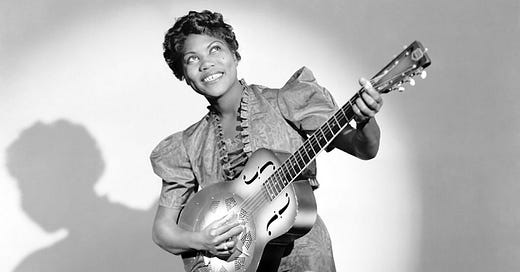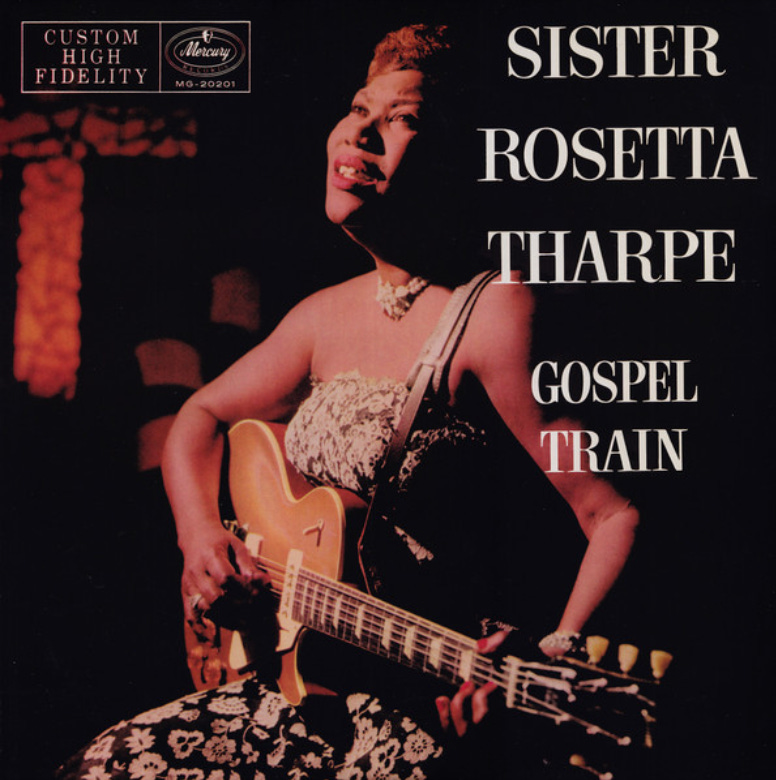Shout, Sister! SHOUT!!!!!! (say it again!)
“It is the very mark of the spirit of rebellion to crave for happiness in this life”― Henrik Ibsen
In an epic, never-ending battle to trace the beginnings of rock ‘n’ roll, the music of Sister Rosetta Tharpe has been focused on more and more over the recent decades as a true starting point. “The original soul sister” who in the 1930s picked up the electric guitar and brought it to church becoming a bridge between gospel music and the devil’s music of rhythm and blues. She became one of the first great gospel stars, with her iconic stage presence: high heals, Sunday best dress, her chin raised up to amplify her deep dark lion-ferocious voice, and of course that sweet guitar strapped around her, almost seeming like a toy in her huge hands, that she shocked and awed both her congregants and her lord above with her effortless picking and riffing. As her star rose, she made a decision in 1938 to sign to Decca Records and walk a more secular path—a move that separating her from the Pentecostal community that until then was her entire world. She decided to open up her one-of-a-kind mutant church to new audiences…to Harlem’s Cotton Club to the West Coast…to radio, records and television.
Imagine seeing her in a club for the first time: no one….no one looked or sounded like her. She traveled the US igniting the imagination of a whole new audience, including up and coming artists like Little Richard and Elvis who were both experimenting with gospel and r&b practices to create their own sound. Soon came Pops Staples who succeeded her in taking up the guitar for the church, adding a warm, reverent tremolo to his sound and Sister Wynona Carr, practically mentored by Tharpe, whose Specialty Records recordings predates the Aretha Franklin sound by almost a decade.
Until Gayle Wald’s triumphant biography on Tharpe came out in 2008, entitled Shout, Sister, Shout!: The Untold Story of Rock-and-Roll Trailblazer Sister Rosetta Tharpe, Tharpe had been largely forgotten, outside the world of late night djs and record collectors (the usual keepers of such information). Wald was inspired to write the book after discovering that Tharpe was buried in an unmarked grave near where Wald’s grandmother lived. At a recent conference she had seen a clip of Tharpe…I assume the famous one that where she played Up Above My Head on the Gospel Time television show…which is one of my top-ten filmed music performances of all time; the clip and the unmarkedness of her legacy, made a biography seem of the utmost importance. Wald’s book, research fueled by conversations with friends and associates who were still alive at the time, which deals with the racism she was up against and a male-dominated guitar playing world and her sexual fluidity. I am paraphrasing Wald by saying that everything about Tharpe went against the norms of the day…she was all innovation, all evolution.
Tharpe was fearless in her decision to record both gospel and secular numbers, recording Rock Me wayyyy back in 1938, finding a hit with This Train in 1939, Down by the Riverside and Strange Things Happening Every Day in 1944, the latter being the first song to cross the gospel charts into the R&B charts. Strange Things Happening Every Day is considered by some to be the first rock ‘n’ roll record, adding it to the list of first rock ‘n’ roll records that include Hound Dog, Good Rocking Tonight, Cadillac Boogie and its bastard child Rocket 88, Tutti Frutti and Blue Suede Shoes (and I am sure I am forgetting a crucial one).
With Tharpe’s past few decades of massive public rediscovery, her crazed unicorn existence is overshadowed by her robustly acknowledged necessity of being: of course there was an artist that broke down cultural walls and built something unique, something needed to ignite movements and a new sound. And of course it was someone who came from the church, who jumped into the devil’s playground, who took-it-all-and-mixed-it-up with whole new perspectives on how to be an artist and a human. But this human was such an alien in her time…it is incomprehensible to think what she was up against in her day-to-day…how many people she alienated and challenged by her mere existence. And she never stopped evolving, always seeking a new sound, always studying others who were pushing musical boundaries.
Sister Tharpe died in 1973, three years after she had a stroke, and after having her leg amputated as a result of diabetes.
She was only 58 when she passed, yet in her short lifetime she changed everything.
Today would have been her 109th birthday. Happy Birthday SISTER ROSETTA THARPE!! Check out 90 minutes of footage of the sister compiled by a beautiful soul, and of course, 1957’s Gospel Train, one of her greatest albums. There is also a new release coming, featuring unreleased live recordings from a French show Tharpe in 1966 that promises to be incredible. Very psyched for that one, and I will let you know how it is as soon as I get my ears on it.
For those who read The Signal regularly, you will know that the great musician Neil Hagerty got himself in serious legal trouble last year after assaulting a police officer who was checking in on his mental well being. It turns out that Denver has a very progressive take on the mentally ill, and instead of Hagerty going away for a long time, either to jail or to an institution, he has been released with all charges dropped after being helped through his acute illness, which is pretty incredible. Supposedly, he is already making music again. For those who want to dig deeper into his work, I put together an overview of his career on a past Signal.
Top 25 Most Expensive Items Sold on Discogs in February 2024
Discogs’ February most-expensive-item group features a litany of more esoteric mega-purchases than usual. Yes, Led Zeppelin, The Beatles and Taylor records are amongst the golden pile…but the chart toppers include a fair jazz record and a few classical records. that are of no real interest to me. It DOES feature The Electric Hole starring Phil Pullman, also of Relatively Clean Rivers (and whose son was once a FBI Most Wanted member after he had joined the Taliban) but at $4076, I will take the reissue, even if it might be a bootleg (I tried to license some music from Pullman at one point, but he did not want to have anything to do with anything related to his music career). The item I am most green eyed about? Nation Time by free-jazzer Joe McPhee (selling for $2403….still farrrrrr above my budget).
Hide Your Drummers, Spinal Tap Have Begun Filming Their ‘Last Waltz’
Oh yeah…
Tales of Life: The magic of reading and rereading Bernard Malamud
A great article on the heals of a new collection ofd Malamud’s later-period writing (and a solid introduction to the writer for the uninformed). He is not as well known as some of his contemporaries, but is worth digging into (it is a long time since I read one of his short stories…I am going back tonight).
15 Pieces of Classical Music That Showed Up in 'Looney Tunes' Cartoons
I got turned on to some classic classical when I was growing up on Saturday mornings watching bugs and friends. This is a joyride.
Hats off to my friend Jeremy Xido for his documentary and its killer roll-out. Well deserved…an engrossing story.
Following up on a dinosaur theme…
Author’s Prayer
By: Ilya Kaminsky
If I speak for the dead, I must leave
this animal of my body,
I must write the same poem over and over,
for an empty page is the white flag of their surrender.
If I speak for them, I must walk on the edge
of myself, I must live as a blind man
who runs through rooms without
touching the furniture.
Yes, I live. I can cross the streets asking “What year is it?”
I can dance in my sleep and laugh
in front of the mirror.
Even sleep is a prayer, Lord,
I will praise your madness, and
in a language not mine, speak
of music that wakes us, music
in which we move. For whatever I say
is a kind of petition, and the darkest
days must I praise.















